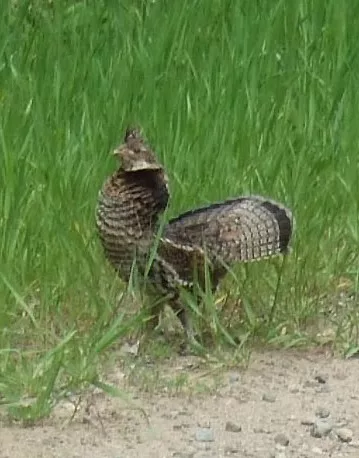
Drying Out. A ruffed grouse dries out along the edge of a gravel forest road after a damp morning. Rains during the peak hatch time period in Minnesota may limit the number of young birds recruited for hunters to pursue, but carry-over of adults is at an all-time high from surveys. Simonson Photo.
By Nick Simonson
Springtime drumming counts of ruffed grouse in Minnesota benefitted from a mild winter, resulting in 2024 tallies hitting fifty-year highs throughout much of the woodland birds’ range in the state. In the northeastern portion of Minnesota, surveyors counted an average of 2.7 drums per stop, the highest average since 1981; statewide counts taking in secondary habitat for the birds were at 2.3, the highest since 1974. These increases were the result of good weather, great habitat and a collaborative surveying effort covering hundreds of thousands of acres, according to Charlotte Roy, Research Scientist for the Minnesota Department of Natural Resources (DNR).
“In that core of the ruffed grouse range they were up ten percent from last year, which is actually the highest they’ve been in about 50 years, so that’s pretty remarkable. We obviously have really good habitat in that part of the state and we’ve been doing really good habitat work,” Roy states.
One potential downside to the upcoming season came after most surveys were conducted, as much of the core range of ruffed grouse in Minnesota was inundated with higher-than-average rainfall during the prime hatching and rearing season for ruffed grouse. Like pheasants, sharptailed grouse and prairie upland birds, ruffed grouse chicks struggle early with thermoregulation shortly after hatch, with limited feather cover to keep them warm. As a result, mortality of some of this year’s hatch of the forestland birds is likely due to the wetter and cooler conditions which made maintaining body temperature difficult for the young birds. However, Roy advises that not all areas were hit by rains equally and carry-over of adult birds will likely sustain good hunting this autumn.
“That peak in the hatch usually occurs in mid-June and that’s about the time that we got a lot of real heavy downpours here in much of Minnesota. It didn’t happen everywhere, and I have heard some good reports of broods from some areas. So, I think what I would recommend is that for folks looking to get out this year and trying to get into some birds, that they try to focus on those areas that didn’t get those torrential downpours in June and be willing to move around and try different areas that might have had less intense rain patterns in June,” Roy advises.
Minnesota has millions of public acres open to hunting throughout the core ruffed grouse range, with stretches of state and national forests including the expansive Superior and Cloquet National Forests in the northeast. Additionally, many wildlife management areas (WMAs) in forested areas of the state are managed specifically for ruffed grouse hunting opportunities, with a variety of tree cover maintained for the birds and designated walking trails kept up for hunters to explore much of the parcels in their pursuit of thunderbirds. Public lands and WMAs open to ruffed grouse hunting can be found on the DNR’s Recreation Compass page at: https://www.dnr.state.mn.us/maps/compass.html. The Minnesota ruffed grouse season runs from Sept. 14, 2024, to Jan. 1, 2025, with a daily limit of five birds.
Simonson is the lead writer and editor of Dakota Edge Outdoors.
